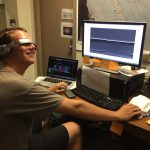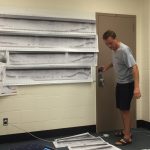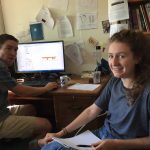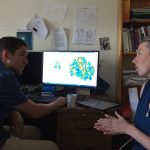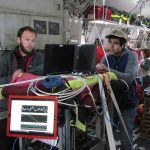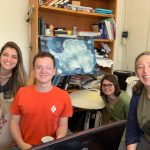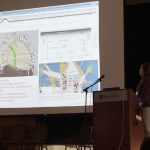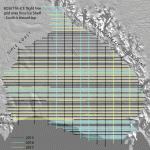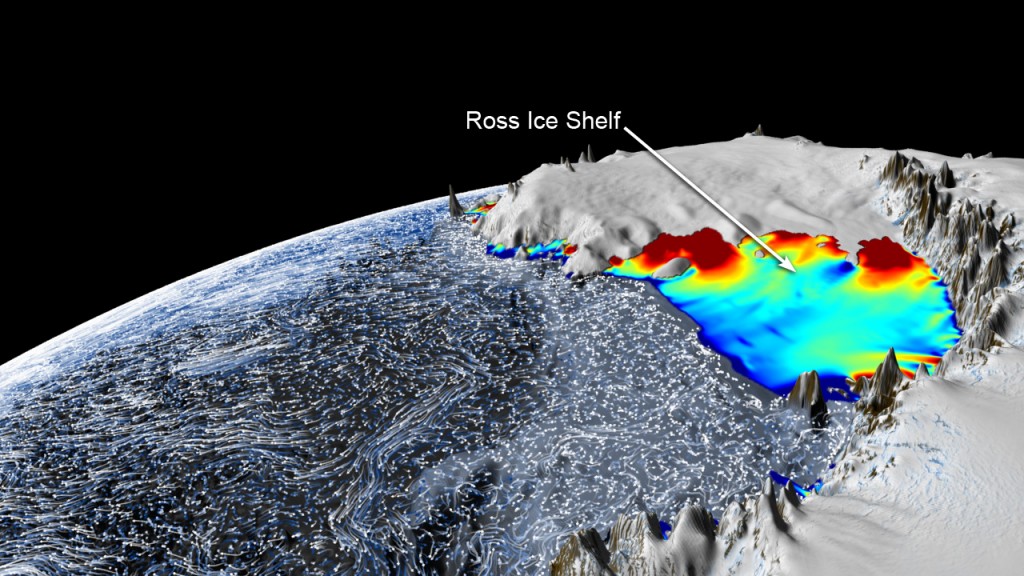
Ocean-ice shelf interaction, frame from https://svs.gsfc.nasa.gov/vis/a000000/a003900/a003948/ice_shelves.mp4 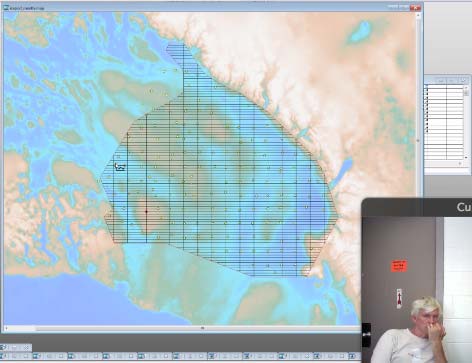
Flight line plan of 2014, via Skype. Co-PI Nick Frearson appears, lower right!
Collaborative Research: Uncovering The Ross Sea Ocean and ice Shelf Environment and Tectonic setting Through Aerogeophysical surveys and modeling of the Ross ICE Shelf (ROSETTA-Ice)
Colorado College joined with three other institutions to carry out airborne exploration of the world’s largest ice shelf, the Ross Ice Shelf in Antarctica. A primary objective was to characterize the crustal structure and bedrock geology beneath the Shelf, by “seeing through” the thick, floating ice sheet and the ocean, below. Critical data for this task were potential fields data: gravity and magnetics. Other objectives were to map the surface topography of the ice shelf, using LiDAR, and determine the internal structure of the ice sheet (comprised of glacier ice formed in East Antarctica and West Antarctica) using two types of airborne radar. Lamont Doherty Earth Observatory (LDEO) of Columbia University led the collaboration funded by NSF, and the other grants went to PIs at Scripps Institution of Oceanography, Earth-Space Research, and Colorado College.
Colorado College undergraduates participated in field data collection, worked with data during internships at LDEO, or conducted senior thesis research on ROSETTA-Ice are Sam Elkind, Alec Lockett, Skye Keeshin, Gina Jozef, and Matt Tankersley. The airborne geophysical surveys were carried out over three seasons, coordinated by LDEO’s Kirsty Tinto, who is a PI, geophysicist, and supreme logistician. The LC-130 aircraft were flown by the New York Air National Guard and supported by McMurdo Station personnel and logistics. GNS Science, New Zealand, and the US Geological Survey contributed instruments and scientific staff.
Outcomes of the ROSETTA-Ice project were models of bathymetry and basement topography Ross Ice Shelf (15 km resolution or better), new understanding of the dimensions and characteristics of the ocean cavity beneath the Shelf, and identification of factors that affect Ross Ice Shelf stability. ROSETTA-Ice publications that report on advances in knowledge of the ice-ocean-continent system are published in Nature Geoscience (2019), JGR-Earth Surface (2020), Journal of Glaciology (2020) and GRL (2020 and 2023). The ROSETTA-Ice high resolution datasets are available online for polar science community investigations.
- Skye Keeshin picking radar profiles
- Sequential radargrams across Ross Ice Shelf
- Matt and Zoe getting down to work on potential fields data
- Werner deconvolution for depth to magnetic basement
- Alec Lockett & co. in LC130
- Jonny Norwine and Sarah Packard join, in 2019
- Dave and Jonny – lookin’ alike?
- Gina Jozef at WAIS 2017
Colorado College undergraduates who worked on ROSETTA-Ice: where are they now? Alec Lockett completed an MSc from University of Iowa (2022). Gina Jozef completed a PhD at University of Colorado – Boulder (2023). Matt Tankersley’s PhD was conferred by Victoria University of Wellington (New Zealand), where Matt continued work on ROSETTA-Ice with GNS Science collaborator Fabio Caratori Tontini. Zoe Krauss entered the PhD program in marine seismology at University of Washington, and has just been awarded NSF graduate research and National Defense Science and Engineering fellowships. Skye Keeshin is employed in the Isotope Laboratory at MIT.
- Flight line map for ROSETTA-Ice survey
- A typical scene: ROSETTA-ICE PIs on a ‘convergence’ call
_____________________________
NSF and NASA awards funded ROSETTA-Ice surveys and science via awards 0958658, 1443534, 1443498, 1443677, 1443497 and 1341688, and NASA NNX16AJ65G. Funds also came from private non-profits: the Moore Foundation and Colorado College. Any opinions, findings, and conclusions or recommendations expressed in this material are those of the author(s) and do not necessarily reflect the views of the National Science Foundation, NASA, Moore Foundation, or Colorado College.


